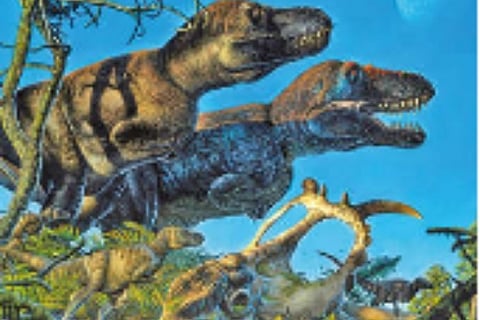

But some dinosaurs had a chiller lifestyle. Deposits of baby dinosaur bones and teeth in northern Alaska, reported Thursday in Current Biology, suggest that a number of species survived year-round above the Arctic Circle enduring freezing temperatures, food shortages and four straight months of darkness, as well as the occasional snowstorm.
The first polar dinosaur footprints were found in 1960, stomped into the Svalbard archipelago. Over the following decades, evidence of dinosaurs at both Arctic and Antarctic latitudes emerged. This led to curiosity about how they managed especially in the northern regions, which, while warmer than they are today, still turned into frozen landscapes of perpetual night during winters.
“How the heck did they do that?” said Patrick Druckenmiller, a paleontologist at the University of Alaska Museum of the North who worked on the new study. Perhaps the dinosaurs were snowbirds, spending summers up there before migrating south, he said. “Or did they somehow tough it out? Or do something crazy, like hibernation?”
For this study, researchers headed to the Prince Creek Formation in northern Alaska, above the Arctic Circle and home to “the polarmost dinosaurs that we know of,” Dr. Druckenmiller said. While the popular image of fossil-hunting also comes from warmer climates — sun-baked paleontologists scratching for clues, femurs jutting out of the ground like hambones — Prince Creek is less glamorous. “The ground is frozen, the bones are frozen,” said Tyler Hunt, a Ph.D. student at Florida State University who worked on the project. “Everything is muddy.” Over the course of several trips, Hunt, Dr. Druckenmiller and other researchers scooped sand and sludge from the Prince Creek hillsides, revealing the frozen layer of fossil-bearing material beneath. After letting the trove thaw in the sun, they dug it out and sifted it through ever-finer mesh screens, keeping anything bigger than a poppyseed. The haul was taken back to the lab, where scores of students and volunteers combed through it one tablespoon at a time under microscopes, checking for tiny shards of bones and teeth called microfossils.
While frequently overlooked in favor of “larger, flashier” remains, microfossils “provide a window into the lives of baby dinosaurs,” as well as the animals and plants they might have coexisted with, said Holly Woodward Ballard, a paleontologist at Oklahoma State University who was not involved with the study. The team found microfossils from at least seven different late Cretaceous dinosaur species, including tyrannosaurs, ridge-headed ceratopsians and duck-billed hadrosaurs. Finding evidence of such young dinosaurs including some that may have not yet hatched helps our understanding of the polar dinosaur lifestyle, Dr. Druckenmiller said. Recent estimates of dinosaur egg incubation times it may have taken up to six months in some cases makes the timeline for winter migration much too tight, he said, adding that they would have had to “step out of the egg and start running south.”Instead, the dinosaurs must have found ways to keep themselves and their offspring warm and fed. It’s likely that some of them had downy feathers, Dr. Druckenmiller said. The finding also supports the increasingly popular idea that dinosaurs were not “cold-blooded, lizard-like creatures,” but rather endotherms, able to create their own body heat, he said.
Visit news.dtnext.in to explore our interactive epaper!
Download the DT Next app for more exciting features!
Click here for iOS
Click here for Android